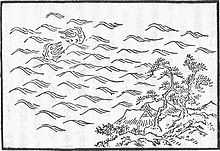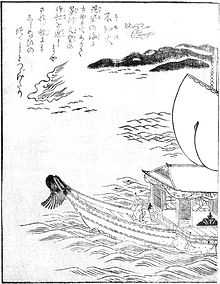Shiranui (optical phenomenon)


Shiranui (不知火 unknown fire, Shiranuhi in the historical kana orthography) is a kaika told about in Kyushu. They are said to appear on days of the noon moon such the kaijitsu (29th or 30th day) of the seventh month of the lunisolar calendary when the wind is weak, in the Yatsushiro Sea and the Ariake Sea.[1] Furthermore, they can be seen in modern time, but they been determined to be an atmospheric optical phenomena.
Summary
Several kilometers from the beach in the open sea, first, one or two called "oyabi" (親火) would appear. These would split off to the left and right and multiply, and in the end, several hundred to several thousand fires would be lined up in a crowd. It is said that they would even stretch to be 4-8 kilometers long.[1] Also, the greatest number of shiranui would be able to be seen at the time of greatest ebb tide at around 3:00AM or within two hours of this time.[2]
They are completely unable to be seen near the water, and it is said that they are able to be confirmed at a height of about 10 meters from the ground.[2] Also, it is certainly impossible to get close to these shiranui, and by attempting to get close, these fires would go far off.[2] They were once said to be the lamp of the dragon god, and nearby fishing villages would prohibit fishing on days when a shiranui was seen.[3]
According to the Nihon Shoki, the Hizen no Kuni Fudoki, and the "Higo no Kuni Fudoki," when Emperor Keiko, went to southern Kyushu to conquer the natives and visited Kumamoto, it is said that they advanced using the shiranui as a landmark. In his journey for expanding the Yamato Ōken, saw unexplainable spots of moving fire, Shiranui, in the Ariake Sea and the Yatsushiro Sea (also called the Shiranui Sea), and a gozoku in that land replied that he did not know the fire, the origin of Shiranui. This light was named Shiranui ("unknown light") and the area was named Hi Province (火国 or 肥国 Hi no kuni , land or country of fire), now Kumamoto Prefecture.[1][3]
History
In 1835, Nakashima Hiroashi wrote a book entitled On the Shiranui:
Many people gather to witness Shiranui even from remote areas. I myself watched Shiranui many times. The Shiranui appears 8 to 12 kilometers distant from the seashore, but it was not sure since it was very dark. At first, one or two spots of fire appear late at night. This is named oya-dama or father fire. Then, the distance between the fires becomes longer, and subsequently, spots of fires appear and disappear as time goes by, and late at night it may become continuous. The lights appear like stars. At dawn, they disappear. When rain and strong wind come, Shiranui does not appear. Many people watch Shiranui from mountains, and they enjoy drinking sake there.[4]
From time immemorial, the Gulf of Shimabara, (near Ariake Sea), Japan, has been famed for Shiranui, the unknown fire, which appears from time to time. The phenomenon occurs twice a year, about 30 September and 24 February, from some time after midnight until the approach of dawn. Sometime the light is a large ball of fire rising from the surface of the sea to a height of 60 feet; sometimes it is a line of pale red, firery globes drifting and down the tide.[5]
Hypotheses of Shiranui
- Dragon which lives under the sea emitting light.
- Reflection of star lights
- Luminous jellyfish
- Fire from undersea active volcano
- Flying saucers
- Fireballs(ghosts)
- Light of fishing boats
- The Japanese Sun Goddess Amaterasu's power after the sun goes down
In the Taisho era, Shiranui attracted the attention of many people, including scholars and newspapermen, who attempted to explain the phenomenon scientifically, and have been explained as a type of mirage. There was a large scale investigation with two ships and more than 50 people in the Ariake Sea in 1916. However, they reported conflicting data and no scientific clarification was reached.[6] According to one theory from the Showa era by Machika Miyanishi, professor of Kumamoto Higher Technical School and Hiroshima Higher Technical School, who made extensive scientific studies and wrote eight papers, including two English papers, the time when shiranui appear is the time when the temperature of the sea is the greatest in the year, and the tide would sink about 6 meters, resulting in a mudflat and sudden radiative cooling, and overlapping with the land formation at the Yatsushiro Sea and the Ariake Sea, the lights of the boats that would depart to get the fish of the tidelands would get refracted.[2] This theory is seen as having merit even in the modern era, and Miyanishi Machika, of the high industries of Kumoto and a professor from the Hiroshima Higher Technical School, researched this as his specialty. According to him, the shiranui are fires for luring fish at night, their flickering and their alliance and rupture, helped with optical illusions, results in it being seen as mysterious flames.[7]
Tairi Yamashita, Professor at Kumamoto University, made extensive studies of Shiranui using modern instruments with the assistance of students. He concluded that "Shiranui is an optical phenomenon resulting from light going through the complicated distributions of clumps of air with different temperatures and getting refracted. Therefore, the source of these lights are fires from private houses and fires used for luring fish, and so on. When these conditions are met, the same kind of phenomenon can be seen in other places and days. For example, road mirages, mirages in general, and heat shimmer are the same type of phenomena.[8] Also, Nobuyuki Marume, in the collection of essays, "Shiranui," published many photographs under the title "Changes of Shiranui with the Passage of Time from Shiranui Town towards the Direction of Amura."[9]
Nowadays, the tidal flats are all filled up, and lightbulbs illuminate the darkness of the night, and as the seawater have become polluted, it has become difficult to see these shiranui.[2]
Explanation by Sakuhei Fujiwhara
The meteorologist Sakuhei Fujiwhara wrote Atmospheric Light Phenomena in 1933, but in it, he wrote that he did not know the cause of shiranui, and due to some who profited from delighting sightseers, he pointed out the possibility that they are from noctiluca.[10]
References
- ↑ 1.0 1.1 1.2 草野巧 (1997). 幻想動物事典. Truth in fantasy. 新紀元社. pp. 171頁. ISBN 978-4-88317-283-2.
- ↑ 2.0 2.1 2.2 2.3 2.4 多田克己 (1990). 幻想世界の住人たち IV 日本編. Truth in fantasy. 新紀元社. pp. 179–181頁. ISBN 978-4-915146-44-2.
- ↑ 3.0 3.1 村上健司編著 (2000). 妖怪事典. 毎日新聞社. pp. 191頁. ISBN 978-4-620-31428-0.
- ↑ Nakashima Hiroashi, On the Shiranui 1835, Akitaya, Osaka, in [Collection:1996]
- ↑ Collection [1983:148] An unidenfied Australian newspaper
- ↑ Suisan Jiho 1916 featuring Shiranui,by Nagasaki Prefecture Fishery World. Collection [1983:84-177]
- ↑ 宮西[1943:文献集310]
- ↑ 不知火資料収集委員会[1993:457]
- ↑ 不知火資料収集委員会[1993:6枚目]
- ↑ 藤原咲平『大気中の光象』日本現代気象名著選集第4巻 2010 大空社 (旧著 鉄塔書院 1933)
Sources
- A study of Shiranui. Miyanishi Machika. Dainippon Shuppan Kabushiki Kaisha. 1943.
- A collection of references on Shiranui. Shiranui reference collecting committee. 1993. Shiranui Town.
- Investigation on Shiranui I. Tairi Yamashita. Kumamoto University Department of Education Kiyo. Vo. 21 1972.
- Investigation on Shiranui II Tairi Yamashita. Kumamoto University Department of Education Kiyo. Vol. 33, 1984.
- Changes of Shiranui with the Passage of Time from Shiranui Town towards the Direction of Amura. Nobuyuki Marume. Photographs, 9th collection.
- A study of Shiranui. Tairi Yamashita. 1994. Ashi Shobou. ISBN 4-7512-0576-5
- A new study of Shiranui. Iwao Tateishi.1994. Tsukiji Shokan. ISBN 4-8067-1047-4